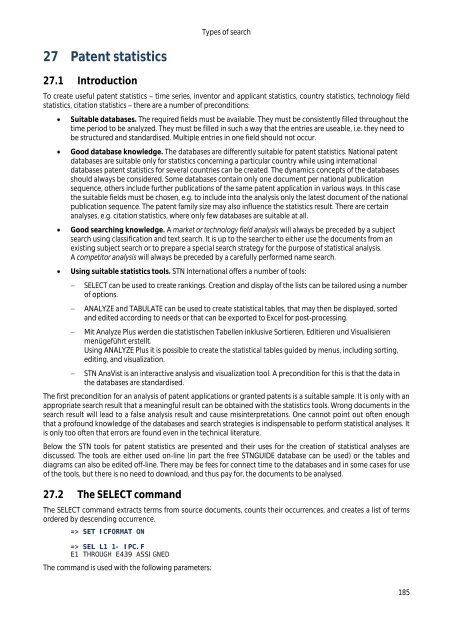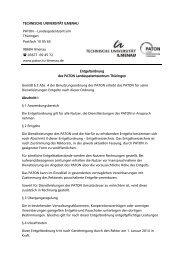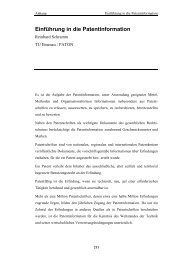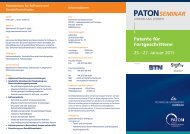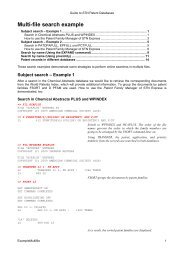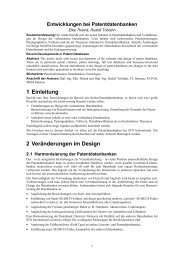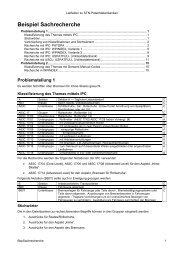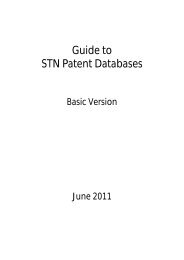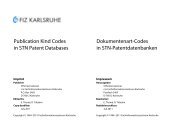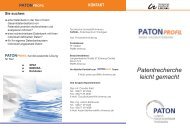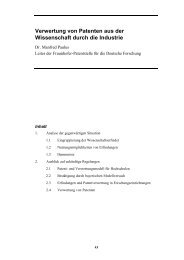Guide to STN Patent Databases – Basic Version - Paton - TU Ilmenau
Guide to STN Patent Databases – Basic Version - Paton - TU Ilmenau
Guide to STN Patent Databases – Basic Version - Paton - TU Ilmenau
You also want an ePaper? Increase the reach of your titles
YUMPU automatically turns print PDFs into web optimized ePapers that Google loves.
27 <strong>Patent</strong> statistics<br />
27.1 Introduction<br />
Types of search<br />
To create useful patent statistics time series, inven<strong>to</strong>r and applicant statistics, country statistics, technology field<br />
statistics, citation statistics there are a number of preconditions:<br />
Suitable databases. The required fields must be available. They must be consistently filled throughout the<br />
time period <strong>to</strong> be analyzed. They must be filled in such a way that the entries are useable, i.e. they need <strong>to</strong><br />
be structured and standardised. Multiple entries in one field should not occur.<br />
Good database knowledge. The databases are differently suitable for patent statistics. National patent<br />
databases are suitable only for statistics concerning a particular country while using international<br />
databases patent statistics for several countries can be created. The dynamics concepts of the databases<br />
should always be considered. Some databases contain only one document per national publication<br />
sequence, others include further publications of the same patent application in various ways. In this case<br />
the suitable fields must be chosen, e.g. <strong>to</strong> include in<strong>to</strong> the analysis only the latest document of the national<br />
publication sequence. The patent family size may also influence the statistics result. There are certain<br />
analyses, e.g. citation statistics, where only few databases are suitable at all.<br />
Good searching knowledge. A market or technology field analysis will always be preceded by a subject<br />
search using classification and text search. It is up <strong>to</strong> the searcher <strong>to</strong> either use the documents from an<br />
existing subject search or <strong>to</strong> prepare a special search strategy for the purpose of statistical analysis.<br />
A competi<strong>to</strong>r analysis will always be preceded by a carefully performed name search.<br />
Using suitable statistics <strong>to</strong>ols. <strong>STN</strong> International offers a number of <strong>to</strong>ols:<br />
SELECT can be used <strong>to</strong> create rankings. Creation and display of the lists can be tailored using a number<br />
of options.<br />
ANALYZE and TABULATE can be used <strong>to</strong> create statistical tables, that may then be displayed, sorted<br />
and edited according <strong>to</strong> needs or that can be exported <strong>to</strong> Excel for post-processing.<br />
Mit Analyze Plus werden die statistischen Tabellen inklusive Sortieren, Editieren und Visualisieren<br />
menügeführt erstellt.<br />
Using ANALYZE Plus it is possible <strong>to</strong> create the statistical tables guided by menus, including sorting,<br />
editing, and visualization.<br />
<strong>STN</strong> AnaVist is an interactive analysis and visualization <strong>to</strong>ol. A precondition for this is that the data in<br />
the databases are standardised.<br />
The first precondition for an analysis of patent applications or granted patents is a suitable sample. It is only with an<br />
appropriate search result that a meaningful result can be obtained with the statistics <strong>to</strong>ols. Wrong documents in the<br />
search result will lead <strong>to</strong> a false analysis result and cause misinterpretations. One cannot point out often enough<br />
that a profound knowledge of the databases and search strategies is indispensable <strong>to</strong> perform statistical analyses. It<br />
is only <strong>to</strong>o often that errors are found even in the technical literature.<br />
Below the <strong>STN</strong> <strong>to</strong>ols for patent statistics are presented and their uses for the creation of statistical analyses are<br />
discussed. The <strong>to</strong>ols are either used on-line (in part the free <strong>STN</strong>GUIDE database can be used) or the tables and<br />
diagrams can also be edited off-line. There may be fees for connect time <strong>to</strong> the databases and in some cases for use<br />
of the <strong>to</strong>ols, but there is no need <strong>to</strong> download, and thus pay for, the documents <strong>to</strong> be analysed.<br />
27.2 The SELECT command<br />
The SELECT command extracts terms from source documents, counts their occurrences, and creates a list of terms<br />
ordered by descending occurrence.<br />
=> SET ICFORMAT ON<br />
=> SEL L1 1- IPC.F<br />
E1 THROUGH E439 ASSIGNED<br />
The command is used with the following parameters:<br />
185


